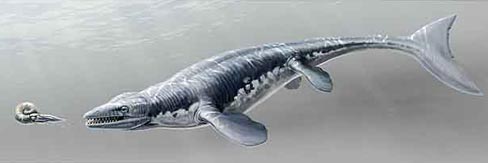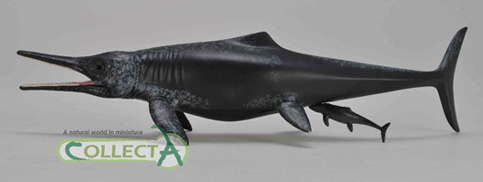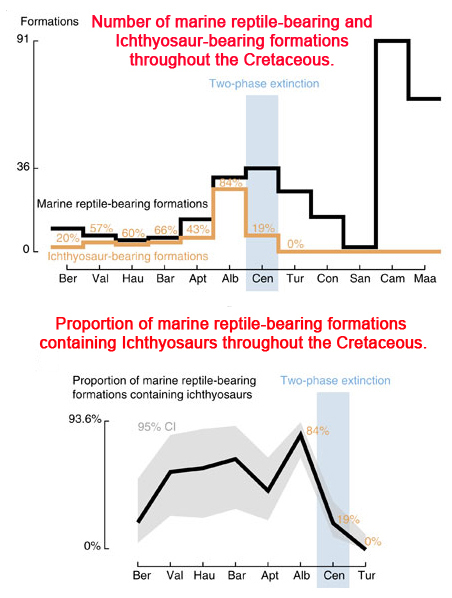Climate Change and an Inability to Evolve Led to Ichthyosaur Extinction
New Study Suggests Reasons for the Extinction of the Ichthyosaurs
A study undertaken by an international team of scientists and published in the open access journal “Nature Communications”, concludes that the extinction of the ichthyosaurs was probably due to an inability to evolve quickly enough in combination with intense climate change.
Superbly Adapted to a Marine Environment – The Ichthyosauria
Picture credit: Everything Dinosaur
Studying Ichthyosaur Extinction
Widely regarded as perhaps, the best adapted of all the marine reptiles of the Mesozoic, the ichthyosaurs with their stream-lined bodies, well developed fins varied diets and their viviparity (live birth as evidenced in a number of fossil specimens), died out some twenty-eight million years or so before the end Cretaceous mass extinction that saw the end of the dinosaurs and other types of marine reptile such as the mosasaurs and the long-necked plesiosaurs.
The reason(s) for this demise have long been debated. During the mid part of the 20th century it had been suggested that the ichthyosaurs had persisted until the end of the Cretaceous, however, most palaeontologists now agree that the very last of these “fish lizards” died out at the end of the Cenomanian faunal stage, some 93 million years ago, a time when the world was undergoing a period of dramatic climate change.
The Rise of the Mosasaurs Not to Blame
The rapid evolution and radiation of the mosasaurs during the Late Cretaceous had been proposed as a possible factor in the extinction of the ichthyosaurs. Many academics had argued that these lizards, (Squamata), competed with the ichthyosaurs for food and other resources such as breeding grounds. However, recent studies have indicated that the earliest large-bodied mosasauroids, animals which could have competed with the ichthyosaurs, first appear in strata laid down in the Middle Turonian stage of the Late Cretaceous some three million years after the last appearance in the fossil record of the Ichthyopterygia Order (also called the Ichthyosauria).
It is likely that the mosasaurs benefited from the absence of the ichthyosaurs and rapidly radiated to fill some of the niches once occupied by them.
The Evolution of the Mosasaurs Not Likely to be the Cause for Ichthyosaur Extinction

Ancestral Mosasaurs during the Cenomanian faunal stage were small, the first large bodied Mosasaurs did not evolve until around 90 million years ago
Picture credit: Stephanie Abramowicz (The Dinosaur Institute, Natural History Museum of Los Angeles County)
Explaining the Extinction
Lead author of the research paper, Dr Valentin Fischer (Oxford University and the University of Liège, Belgium), explained that the research team carried out an extensive analysis of the geological record of the Ichthyosaurs, combing through data that represented the last 120 million years of this Order’s evolutionary history.
He stated:
“We analysed the extinction of this crucial marine group thoroughly for the first time. We compared the diversity of the ichthyosaurs with the geological record of global change, emphasising the dynamics of these datasets. Ichthyosaurs were actually well diversified during the last chapter of their reign, with several species, body shapes and ecological niches present. However, their evolution was much slower than earlier in their history. Additionally, they were seemingly negatively affected by the profound global changes going on during the Cretaceous, as their extinction rate correlates with environmental volatility.”
Everything Dinosaur stocks a variety of marine reptile models including several replicas of ichthyosaurs: Marine Reptiles, Ichthyosaurs and Sea Monster Models.
A Perfect Storm for the Ichthyosauria
It seems that the Ichthyosauria endured a severe decline in the number of species at the beginning of the Cenomanian. Many specialist predators of soft-bodied creatures, died out along with several “generalist” ichthyosaurs, but those ichthyosaur species that filled apex predator roles seem to have persisted until the end of this faunal stage.
A two-pronged event is suggested to have added up to the “perfect storm” for the Ichthyosauria. At this time, the Earth’s poles were free of ice and sea levels were much higher than today. The analysis revealed that this two-phase extinction event (Early Cenomanian and Late Cenomanian), can be associated both with reduced evolutionary rates (a failure to evolve novel body plans for a prolonged period of geological time) and dramatic climate change (strong fluctuations in sea surface temperatures and sea levels).
The International Research Team Plotted the Demise of the Ichthyosauria
Picture credit: Nature Communications
The two graphs above were compiled by the international research team. The top graph shows the number of marine reptile-bearing formations recorded throughout the whole of the Cretaceous (black line), plotted against the proportion of these formations that contain ichthyosaur fossils (beige line). The proportion of marine reptile-bearing formations yielding ichthyosaurs decreased from 84% in the Albian to 19% in the Cenomanian and to 0% in the Turonian. The bottom graph, plots the proportion of marine reptile-bearing formations containing ichthyosaurs throughout the Cretaceous, with calculation of a 95% confidence interval.
Ichthyosauria Did Become Rarer
These graphs indicate that the extinction is not biased by a lack of fossils of ichthyosaurs, it seems that the Ichthyosauria did indeed become rarer and rarer and then disappeared from the oceans of the world, at a time when other marine reptile populations were recovering from any extinction pressures.
Dr Fischer added:
“Although the rising temperatures and sea levels evidenced in rock records throughout the world may not directly have affected ichthyosaurs, related factors such as changes in food availability, migratory routes, competitors and birthing places are all potential drivers, probably occurring in conjunction to drive ichthyosaurs to extinction.”
For models and replicas of ichthyosaurs and other prehistoric animals: CollectA Age of Dinosaurs Prehistoric Animal Models.
This new work supports a growing body of evidence suggesting that a major, global, change-driven turnover profoundly reorganised marine ecosystems at the beginning of the Late Cretaceous (Cenomanian faunal stage), giving rise to the highly peculiar and geologically brief Late Cretaceous marine world. Ichthyosaurs disappeared in the course of this turnover, while numerous lineages of bony fishes and sharks evolved.
It is also suspected that surface levels of oxygen were depleted during the Cenomanian. This may have impacted on the strength and vigour within food chains, with the apex predators such as those remaining types of ichthyosaur, at the top of the food chain, affected more than most. The extinction of ichthyosaurs thus appears to be one aspect of a larger event, something the team, which includes scientists from England, Russia, Belgium and France is currently investigating.
To read a related article written by Everything Dinosaur in 2013, that looked at how fossil finds from Iraq were changing views on the evolution of the Ichthyosauria: Fossilised “Fish Lizard” Changing Views of Ichthyosaur Evolution.



